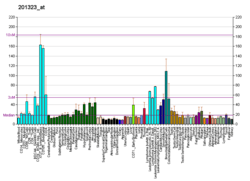Probable rRNA-processing protein EBP2 is a protein that in humans is encoded by the EBNA1BP2 gene.[5][6][7]
References
- 1 2 3 GRCh38: Ensembl release 89: ENSG00000117395 - Ensembl, May 2017
- 1 2 3 GRCm38: Ensembl release 89: ENSMUSG00000028729 - Ensembl, May 2017
- ↑ "Human PubMed Reference:".
- ↑ "Mouse PubMed Reference:".
- ↑ Shire K, Ceccarelli DF, Avolio-Hunter TM, Frappier L (May 1999). "EBP2, a human protein that interacts with sequences of the Epstein-Barr virus nuclear antigen 1 important for plasmid maintenance". J Virol. 73 (4): 2587–95. PMC 104013. PMID 10074103.
- 1 2 Reimers K, Antoine M, Zapatka M, Blecken V, Dickson C, Kiefer P (Jul 2001). "NoBP, a nuclear fibroblast growth factor 3 binding protein, is cell cycle regulated and promotes cell growth". Mol Cell Biol. 21 (15): 4996–5007. doi:10.1128/MCB.21.15.4996-5007.2001. PMC 87226. PMID 11438656.
- ↑ "Entrez Gene: EBNA1BP2 EBNA1 binding protein 2".
Further reading
- Chatterjee A, Freeman JW, Busch H (1987). "Identification and partial characterization of a Mr 40,000 nucleolar antigen associated with cell proliferation". Cancer Res. 47 (4): 1123–9. PMID 2879624.
- Sherrington R, Rogaev EI, Liang Y, et al. (1995). "Cloning of a gene bearing missense mutations in early-onset familial Alzheimer's disease". Nature. 375 (6534): 754–60. doi:10.1038/375754a0. PMID 7596406.
- Maruyama K, Sugano S (1994). "Oligo-capping: a simple method to replace the cap structure of eukaryotic mRNAs with oligoribonucleotides". Gene. 138 (1–2): 171–4. doi:10.1016/0378-1119(94)90802-8. PMID 8125298.
- Suzuki Y, Yoshitomo-Nakagawa K, Maruyama K, et al. (1997). "Construction and characterization of a full length-enriched and a 5'-end-enriched cDNA library". Gene. 200 (1–2): 149–56. doi:10.1016/S0378-1119(97)00411-3. PMID 9373149.
- Huber MD, Dworet JH, Shire K, et al. (2000). "The budding yeast homolog of the human EBNA1-binding protein 2 (Ebp2p) is an essential nucleolar protein required for pre-rRNA processing". J. Biol. Chem. 275 (37): 28764–73. doi:10.1074/jbc.M000594200. PMID 10849420.
- Henning D, Valdez BC (2001). "Expression of p40/Epstein-Barr virus nuclear antigen 1 binding protein 2". Biochem. Biophys. Res. Commun. 283 (2): 430–6. doi:10.1006/bbrc.2001.4780. PMID 11327720.
- Andersen JS, Lyon CE, Fox AH, et al. (2002). "Directed proteomic analysis of the human nucleolus". Curr. Biol. 12 (1): 1–11. doi:10.1016/S0960-9822(01)00650-9. PMID 11790298.
- Strausberg RL, Feingold EA, Grouse LH, et al. (2003). "Generation and initial analysis of more than 15,000 full-length human and mouse cDNA sequences". Proc. Natl. Acad. Sci. U.S.A. 99 (26): 16899–903. doi:10.1073/pnas.242603899. PMC 139241. PMID 12477932.
- Kapoor P, Frappier L (2003). "EBNA1 partitions Epstein-Barr virus plasmids in yeast cells by attaching to human EBNA1-binding protein 2 on mitotic chromosomes". J. Virol. 77 (12): 6946–56. doi:10.1128/JVI.77.12.6946-6956.2003. PMC 156160. PMID 12768013.
- Gerhard DS, Wagner L, Feingold EA, et al. (2004). "The status, quality, and expansion of the NIH full-length cDNA project: the Mammalian Gene Collection (MGC)". Genome Res. 14 (10B): 2121–7. doi:10.1101/gr.2596504. PMC 528928. PMID 15489334.
- Kapoor P, Lavoie BD, Frappier L (2005). "EBP2 plays a key role in Epstein-Barr virus mitotic segregation and is regulated by aurora family kinases". Mol. Cell. Biol. 25 (12): 4934–45. doi:10.1128/MCB.25.12.4934-4945.2005. PMC 1140579. PMID 15923612.
- Ewing RM, Chu P, Elisma F, et al. (2007). "Large-scale mapping of human protein-protein interactions by mass spectrometry". Mol. Syst. Biol. 3 (1): 89. doi:10.1038/msb4100134. PMC 1847948. PMID 17353931.




